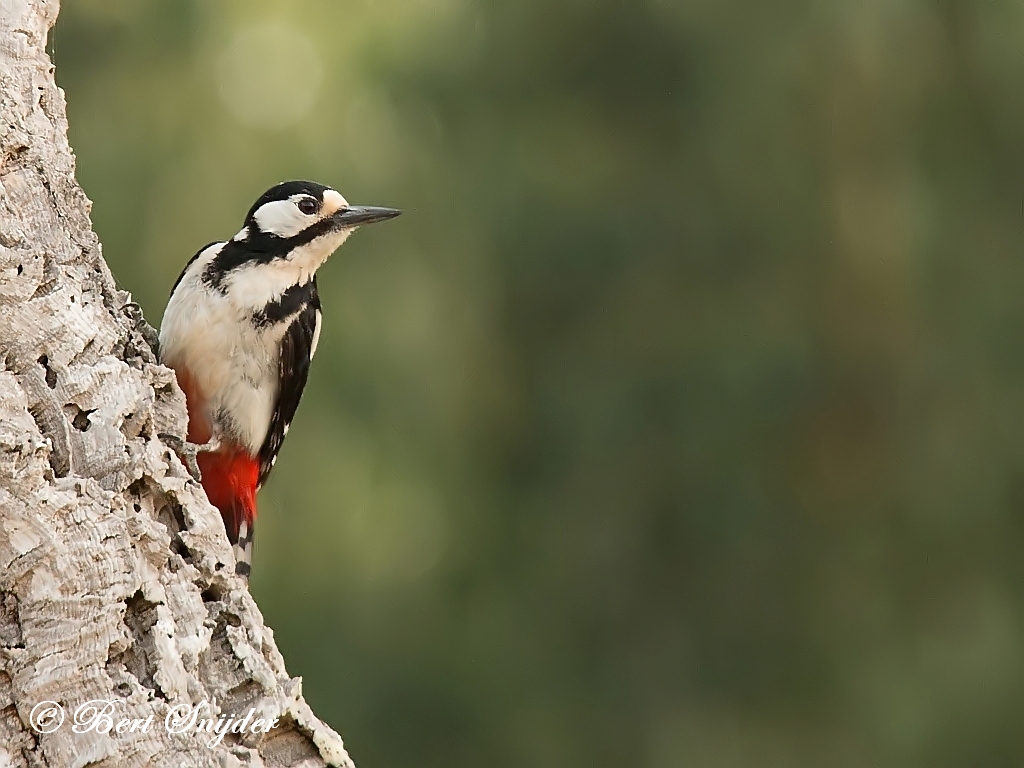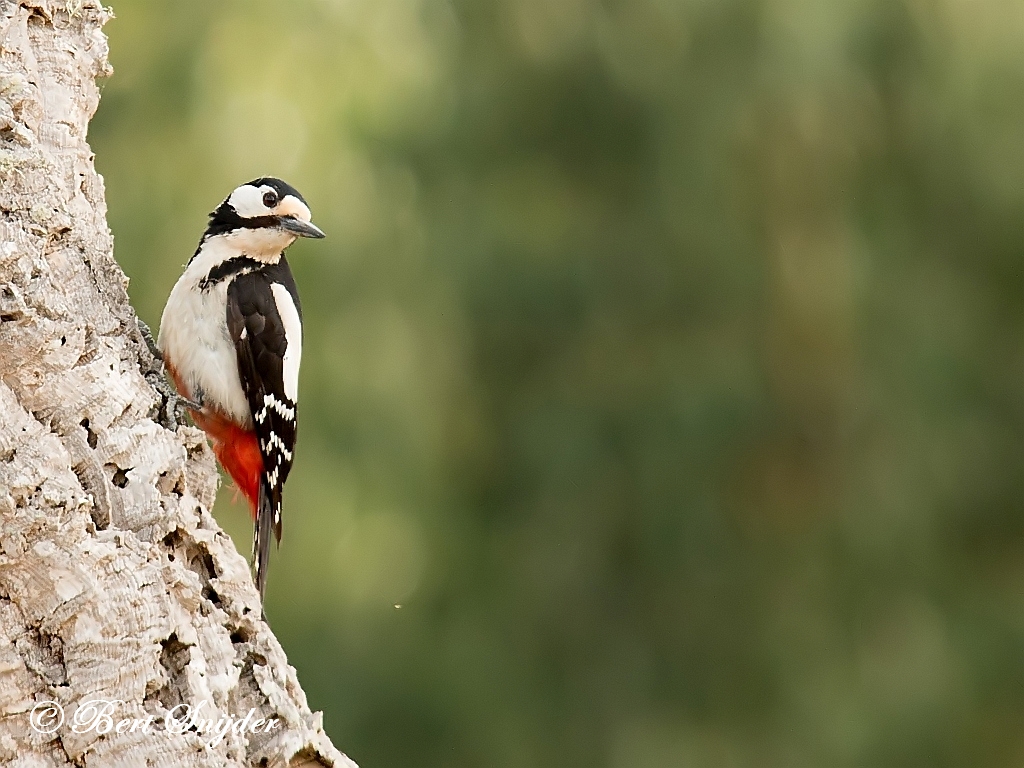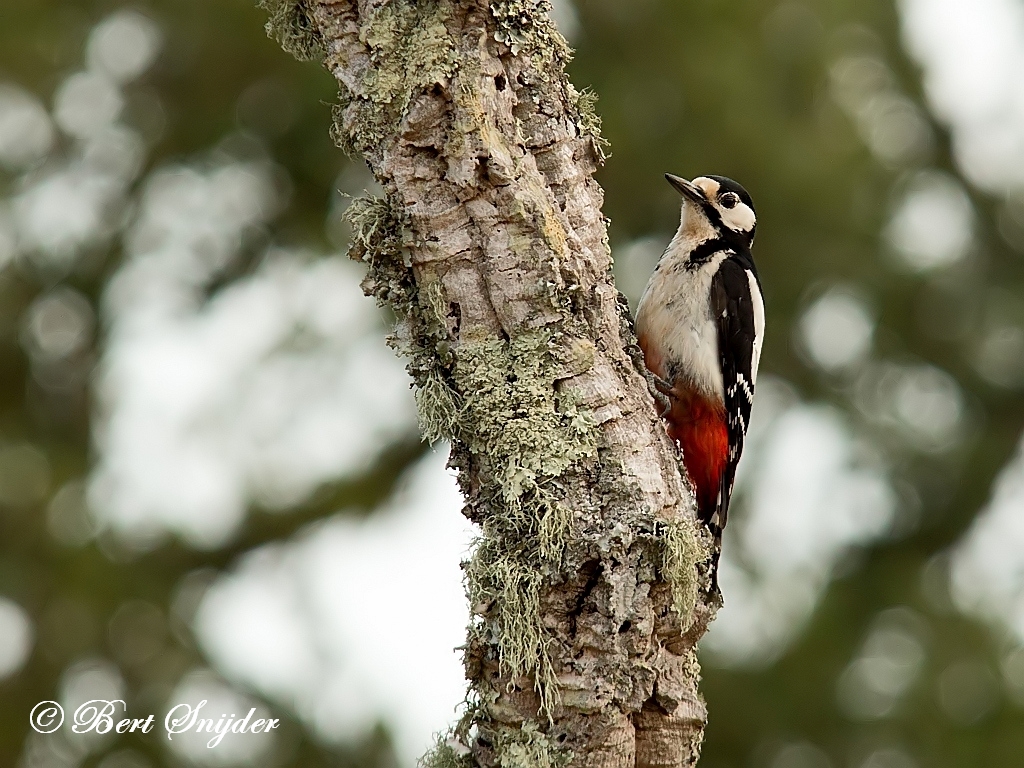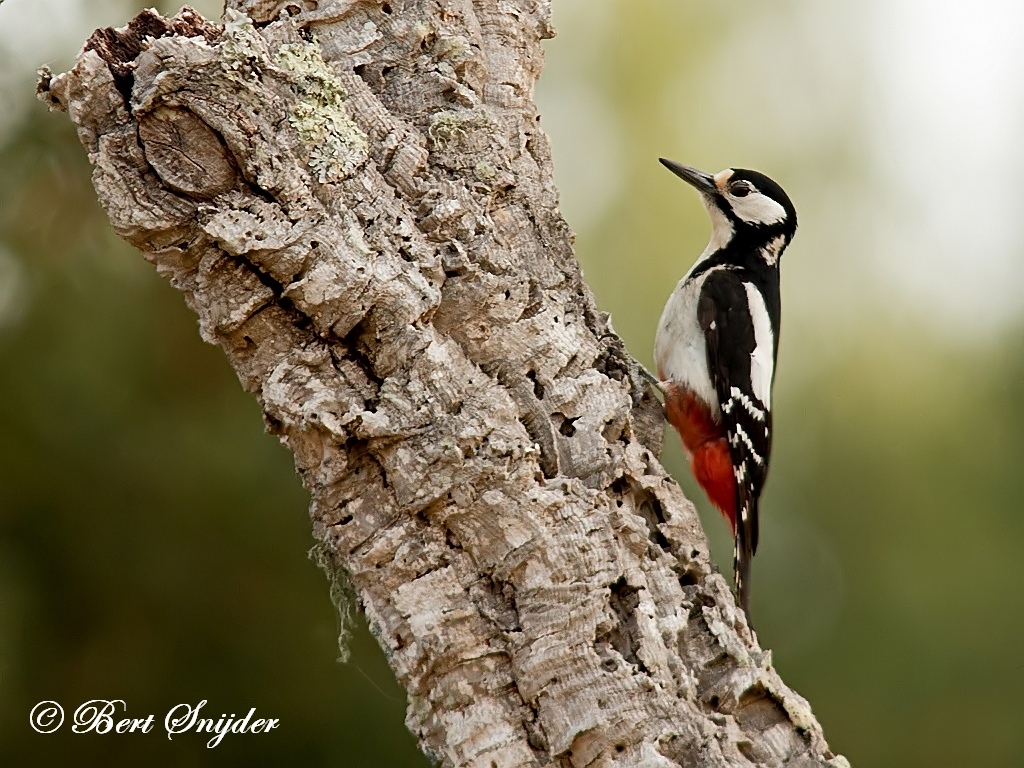Great Spotted Woodpecker, Grote Bonte Specht, Buntspecht, Pica-pau-malhado-grande, Pico picapinos
Spotted on Monte Horizonte in the Alentejo region of Portugal. Great Spotted Woodpecker sound
The Great Spotted Woodpecker (or Greater Spotted Woodpecker), Dendrocopos major, is a bird species of the woodpecker family (Picidae). It is distributed throughout Europe and northern Asia, and usually resident year-round except in the colder parts of its range. It is not considered a threatened species by the IUCN, being widely distributed and quite common.

More photos at the bottom of this page:
The Great Spotted Woodpecker is 23-26 cm long, with a 38-44 cm wingspan. The upperparts are glossy black, with white on the sides of the face and neck. A black line zigzags from the shoulder halfway across the breast (in some subspecies nearly meeting in the center), then back to the nape; a black stripe, extending from the bill, runs below the eye to meet this latter part of the zigzag line. On the shoulder is a large white patch and the flight feathers are barred with black and white. The three outer tail feathers are barred; these show when the short stiff tail is outspread, acting as a support in climbing. The underparts are dull white, the abdomen and undertail coverts crimson. The bill is slate black and the legs greenish grey.
Males have a crimson spot on the nape, which is absent in females and juvenile birds. In the latter, the top of the head is crimson between the bill and the center of the crown instead.
Despite its contrasting plumage, the Great Spotted Woodpecker is often an inconspicuous bird. The large white shoulder patch is the feature that most easily catches the eye. When hidden by the foliage, its presence is often advertised by the mechanical drumming, a vibrating rattle, produced by the rapidly repeated blows of strong bill upon a trunk or branch. This is not a dedicated courtship call or challenge, but a signal of either sex to announce its presence. It is audible from a great distance, depending on the wind and the condition of the wood, a hollow bough naturally producing a louder note than living wood. The call is a sharp quet, quet.
The Great Spotted Woodpecker has several living subspecies. The paleosubspecies D. m. submajor lived during the Middle Pleistocene Riss glaciation (250.000 to 300.000 years ago); it was found in Europe south of the ice sheet. It is sometimes treated as a distinct species, but did not differ from the living Great Spotted Woodpecker of Europe except in size; the European subspecies of our time are probably its direct descendants.
The male Great Spotted Woodpecker is almost unmistakeable. The only species that are quite similar are the Syrian Woodpecker (D. syriacus) and the White-winged Woodpecker (D. leucopterus). The former differs in the less well-developed zigzag stripe on the neck, which neither reaches as far towards the center of the breast nor meets the black of the nape as it does in Great Spotted Woodpeckers. The latter has a far more extensive white wing patch.
Females can be distinguished from female Syrian Woodpeckers and White-winged Woodpeckers in the same way as males; the female Sind Woodpecker (D. assimilis) looks also similar but does not have the zigzag stripe reaching the nape. Great Spotted Woodpecker females can also be confused with a female White-backed Woodpecker (D. leucotos). However, the latter species lacks the white shoulder patch, having an all-white lower back instead; it also has a less well-developed zigzag stripe on the neck, just like the Syrian Woodpecker. The female Himalayan Woodpecker (D. himalayensis) is also similar, but it can be distinguished by the same characteristics as the female Syrian Woodpecker.
Immature birds resemble the Middle Spotted Woodpecker (D. medius), the male White-backed Woodpecker, the immature Syrian and White-winged Woodpeckers, and male or immature Lesser Spotted Woodpeckers (Picoides minor, formerly also in Dendrocopos). The first of these species has only an angular cheek spot instead of the zigzag stripe, while the White-backed and Lesser Spotted Woodpeckers lack the white shoulder patch and have a less well-developed zigzag stripe, as described above. The Lesser Spotted Woodpecker also has no red on the abdomen. White-backed Woodpeckers are also larger, while Lesser Spotted Woodpeckers are smaller than immature Great Spotted Woodpeckers. Differences from Syrian and White-winged Woodpeckers are the same as for adults.
Female foraging for grubsIt is an inhabitant of woodlands and parks, depending for food and nesting sites upon old trees. Its actions are jerky, and it hops rather than climbs, leaping forward with one foot just in advance of the other. When a space is crossed the flight is easy and undulating.
The food mainly consists of insects and grubs but also seeds, fruit, scraps, eggs, chicks and small rodents. The woodpecker usually alights on the trunk, working upwards, from side to side, but sometimes will perch in passerine style, when it sits well upright. During the ascent it taps the bark, breaking off fragments, but often extracts its prey from crevices with the tip of its sticky tongue. Beechmast, acorns, nuts and berries are eaten when animal food is scarce.
The nesting hole, neat and round, is bored in soft or decaying wood horizontally for a few inches, then perpendicularly down. At the bottom of a shaft, usually from six to twelve inches in depth, a small chamber is excavated and lined with wood chips. This woodpecker shows no marked preference for particular tree taxa, building its nest in gymnosperms and angiosperms alike.
Nesting trees chosen by this woodpecker almost invariably have soft heartwood and tough sapwood, often due to parasites or diseases that weaken the heartwood only. It is unknown how D. major finds suitable trees, though it is entirely possible that they do so by drumming, making use of the different speed of sound in materials with differing elastic modulus and density. Tree species which are rarely or never used for nesting might simply not have wood with the required properties.
The creamy-white eggs, five to seven in number, are laid in the second half of May. The young cluster at the mouth of the hole and keep a continuous chatter when the parents are feeding them, but when alarmed slip back into the hole. The nest hole is rarely used again, but not infrequently other holes are bored in the same tree.







Other synonyms:
Breton: Ar pilkoad bras, Drailher-koad, pilkoad bras
Catalan: Picot garser gros
Czech: Strakapoud velký
Welsh: Cnocell brith, Cnocell brith mwyaf, cnocell fraith fwyaf, Cobler y coed, Coblyn mwyaf, Coblyn y coed, Cymynwr y coed, Delor fraith, Taradr y coed, Tyllwr y coed
Danish: Stor flagspætte
German: Buntspecht, Grosser Specht, Rotspecht
English: Great Spotted Woodpecker, Great woodpecker, Greater Pied Woodpecker, Red-crowned Pied Woodpecker
Esperanto: granda buntpego
Spanish: Carpintero Picapinos, Pico Picapinos
Estonian: Suur-kirjurähn
Basque: okil handi, Okil handia, Picot garser gros
Finnish: Käpytikka
Faroese: Spetta, Stoór flekkuspæta, stór flekkuspæta
French: Pic épeiche
Friulian: pic de corone
Frisian: grutte eksterspjocht
Irish: mórchnagaire breac, peto real
Gaelic: Snagan Daraich
Galician: Peto real, Picot garser gros
Manx: Snoggeyder, snoggeyder mooar
Croatian: veliki djetao, Veliki Djetlic
Hungarian: Nagy fakopáncs
Indonesian: Caladi
Icelandic: Barrspæta
Italian: Picchio rosso maggiore
Japanese: akagera, Aka-gera
Cornish: Casek-cos bryth, kasek koes vrith
Latin: Dendrocopos major, Dendrocopus major, Picoides major
Ladino: becalen gran
Lithuanian: Didysis genys, didysis margasis genys
Latvian: dižraibais dzenis
Dutch: Grote Bonte Specht
Norwegian: Barspett, Flaggspett, Stor flaggspett
Occitan: pic mar
Polish: Dzieciol czarny
Portuguese: pica pau malhado grande, Pica-pau-malhado-grande, Picapau-malhado-grande
Romansh: pitgalain grond
Romanian: ciocanitoare mare
Russian: pestryj djatel, Pyostry Dyatel
Sardinian: atacadolza, attaccadorza, biccalinna, biccamatta, biccamuru, pappafrumigas, pertunghefustes, pertunghemuru, picculatruncu, pìttau, pittigone, pittulatrunca, pitzulucau, toccatoccafuste, toccheddadòrgia
Scots: cnag mhòr, Snagan daraich
Slovenian: veliki detel
Albanian: qukapiku larosh i madh, Qukapiku larosh kurrizbardhë
Swedish: Större hackspett
Travel Birdwatching Holiday Alentejo, Vacation Portugal for birders to see birds on your trip